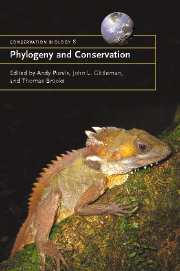Book contents
- Frontmatter
- Contents
- List of contributors
- 1 Phylogeny and conservation
- Part 1 Units and currencies
- 2 Molecular phylogenetics for conservation biology
- 3 Species: demarcation and diversity
- 4 Phylogenetic units and currencies above and below the species level
- 5 Integrating phylogenetic diversity in the selection of priority areas for conservation: does it make a difference?
- 6 Evolutionary heritage as a metric for conservation
- Part 2 Inferring evolutionary processes
- Part 3 Effects of human processes
- Part 4 Prognosis
- Index
- References
5 - Integrating phylogenetic diversity in the selection of priority areas for conservation: does it make a difference?
Published online by Cambridge University Press: 04 December 2009
- Frontmatter
- Contents
- List of contributors
- 1 Phylogeny and conservation
- Part 1 Units and currencies
- 2 Molecular phylogenetics for conservation biology
- 3 Species: demarcation and diversity
- 4 Phylogenetic units and currencies above and below the species level
- 5 Integrating phylogenetic diversity in the selection of priority areas for conservation: does it make a difference?
- 6 Evolutionary heritage as a metric for conservation
- Part 2 Inferring evolutionary processes
- Part 3 Effects of human processes
- Part 4 Prognosis
- Index
- References
Summary
INTRODUCTION
Species are the most frequently used currency of biological diversity (see, for example, Gaston 1996). However, they are not equivalent in terms of the amount of unique evolutionary history they represent, and that would be irreversibly lost if they became extinct (May 1990; Vane-Wright et al. 1991). Classical examples of species that embody disproportionate amounts of evolutionary history are the tuataras (Sphenodon punctatus and S. guntheri), iguana-like reptiles that are the sole survivors of the order Sphenodontia, and the welwitschia (Welwitschia mirabilis), a gymnosperm that is the single representative of the order Welwitschiales (Daugherty et al. 1990; von Willert 1994).
Phylogenetic diversity (PD) is a biodiversity measure that takes account of phylogenetic relationships (and hence evolutionary history) between taxa (Faith 1992, 1994a; Polasky et al. 2001; Rodrigues & Gaston 2002a). The phylogenetic diversity contained in the species that exist today is part of the raw material on which future evolutionary processes will operate. Keeping these pieces is fundamental to leaving the options open for future evolution (Moritz 2002). However, previous studies indicate that PD is being lost at a faster rate than expected from species loss (Purvis et al. 2000; von Euler 2001), and that PD is not evenly distributed throughout the planet (Sechrest et al. 2002), suggesting that conservation action may need to target evolutionary history directly.
For a given clade, the extent to which phylogenetic diversity is more or less evenly spread across species is determined by the structure of the phylogenetic tree.
- Type
- Chapter
- Information
- Phylogeny and Conservation , pp. 101 - 119Publisher: Cambridge University PressPrint publication year: 2005
References
- 63
- Cited by



